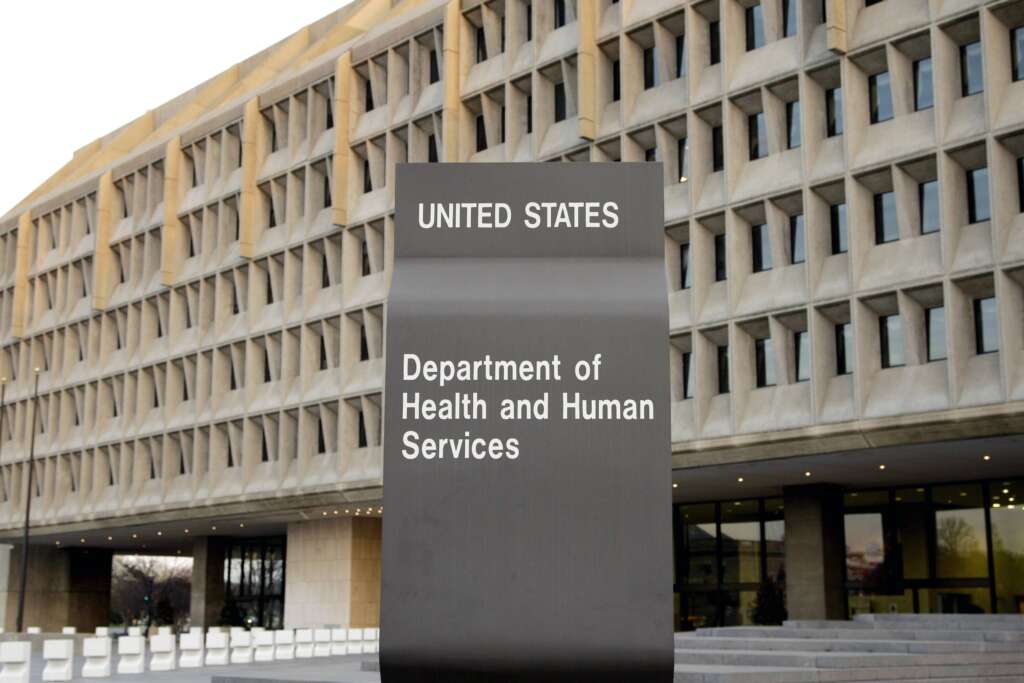
The Advanced Research Projects Agency-Health, ARPA-H, has launched two new programs aimed at the kinds of tough problems the agency specializes in. One deals with artificial intelligence models to predict drug safety. The other with computation systems needed to design vaccines. The Federal Drive with Tom Temin got more details from ARPA-H program manager Dr. Andy Kiliansk.
Tom Temin Well, let’s start with the first one, Artificial intelligence. I don’t think any agency grant activity research project doesn’t touch on artificial intelligence these days, testing drugs and getting drugs approved as a 10,000 page, 10-year-effort. What are you trying to do here?
Andy Kilianski Yeah. So again, thanks for the opportunity to be here. And you’re correct, a lot of the efforts that we’re doing across the government have a plug into the artificial intelligence world. So what we’re trying to do in the Catalyst program, which is the AI enable tools for drug development, is to really increase our chances of success when candidate drugs enter into the clinical pipeline. Typically there’s a few years of preclinical research that happens before, and this occurs with computational models, but also with animal models and other types of wet lab experimentation. And that process leads to less than 10% of all drugs that enter the clinical trial pipeline being licensed. So we have a lot of failure both in efficacy and safety in these drugs. And so what we want to do in the Catalyst program is really create an environment where we can use computational tools to better predict human outcomes based on these pre-clinical experiments.
Tom Temin So the idea would be to avoid that 90% or at least a good portion of the 90% from getting into the pipeline in the first place.
Andy Kilianski Exactly. And what we really fail to do well in clinical trials is to represent population diversity across this country. So what we’re going to be doing in the cannabis program is really stressing bringing in human foundational data that’s representative of this country from a genetic and environmental background to be able to model again in silico with computers, how these candidate pharmaceuticals might impact a wider swath of the population.
Tom Temin And is that just a feel good DEI type of thing, or do we know that there are different effects of a given drug on different segments of the population?
Andy Kilianski No. Drug effects vary widely by genetic background, by environment, by a number of different factors. And typically in preclinical models, we use animals, inbred animal models and things like that which don’t have any population genetic diversity. And we’re using these tools, which have been demonstrated to not actually recapitulate human physiology. Further when we get into something like a phase one clinical trial. It’s typically tens to hundreds of patients. And in a safety evaluation, those are healthy people. Young adults, middle aged adults, 18 to 35 types, and typically don’t accurately represent the broader population diversity both from genetic backgrounds, but also from diseases that they have. And that they carry comorbidities, as well as environmental factors.
Tom Temin Well, the chimpanzees will thank you for this, but it sounds like that there are data sets that can be used, in effect, to digitize what used to be something done to humans and animals.
Andy Kilianski Exactly. So we’re seeking to really innovate on the ways that we collect data from human models and human beings, but also from a wide variety of these 3D printed organs that we’re also investing in. Ways to really leverage data from these tools to better simulate our own physiology as humans.
Tom Temin And is there the assumption then that what we can know about what’s happened already, given all this data about effects can be backed up into the design of new drugs at the outset?
Andy Kilianski Yes, 100%. The goal of the program is to really innovate on how we get to first thing human trial approval. So we do all of these experiments ahead of time and then a drug developer will go to the FDA and will present a package called a investigational new drug package that details how they’ve evaluated safety within their candidate pharmaceutical. And they ask for approval to get into a phase one clinical trial. Typically, those experiments involve animals, varieties of different types of animal models. And in this area of drug development, not much has changed over the past 50 years. We still use many of the same tools that we’ve used while we’re innovating rapidly in the upstream parts of drug discovery, target selection, taking a billion chemicals and narrowing that down to 10 potential candidates for a given target. And what we’d like to do is really bring that innovation into safety assessment, parts of the drug development process.
Tom Temin We are speaking with Dr. Andy Kilianski. He’s a program manager at the Advanced Research Projects Agency for Health. That’s part of Health and Human Services. And the other program we were talking about is the computation systems needed to design vaccines, which I guess is also computationally intensive. What’s going on with that program?
Andy Kilianski Yeah. So, Tom, you’re seeing a theme here in the programs that we’re launching. My team and our portfolio’s focus is really trying to make biomedical research in development and health research more predictable. So we do a lot of trial and error in these things, especially in vaccine and therapeutic design. And so what we’d like to do, based on our shared experience with COVID 19 and other emerging infectious diseases, is that we need things on the shelves ahead of a future public health emergency. We need things that can target multiple infectious diseases at once and do this in a way that makes these products commercially viable so that we can maintain the ability to respond to things in the future. So the Apex program is focused on using these computational tools, and really pursuing broadly immunogenic protein design in computers, and then evaluating those in animal models and in Congress.
Tom Temin And I heard from the last pandemic, somebody said, I forget who it was, that the ability to rapidly develop the vaccine that we did get for the COVID was because that virus was in a family of viruses that we had already done vaccines for. That’s why it only took a year or something. But there’s 15 other types of virus that have those came onto the scene, were cooked as humanity.
Tom Temin Is that true? And can this work you’re doing maybe branch out from the kind of viruses we’re used to, to the ones that haven’t yet gotten out into the wild and start killing people?
Andy Kilianski Yeah. So I actually am a coronavirus researcher by training, and so I did some of that work on the original virus in the lead up to the COVID- 19 pandemic. And so you’re absolutely right. We knew a lot about coronavirus, protein structure and function, and so we were able to design those vaccines relatively quickly. There are other viral families out there which we know a lot less about, but we know in general what that evolutionary diversity looks like. So our program seeks to go up that evolutionary tree to find those real common denominators across viral families and target them from a vaccine therapeutics design perspective. So in this way, we can be prepared for things that we already know exist and build therapeutics and vaccines that work against a variety of different current threats. But then if nature throws something else at us, which we don’t see today, we’ll have a reasonable expectation that the tools we’ve developed will work against those threats as well.
Tom Temin Yeah, so that’s kind of like it’s not exactly artificial intelligence, but it is replacing something that’s wet with something that’s digital.
Andy Kilianski Exactly. Starting from leveraging these AI enabled tools and starting from really our best possible multi target design as opposed to the way we currently do these things, which is really one pathogen to one therapeutic or vaccine. And we’d like to change that paradigm with the next program.
Tom Temin And now we’ve discussed two different programs. What forms do they take? These will be research grants. How do you carry it out? Competitively with funding opportunities, that kind of thing?
Andy Kilianski Yeah. So the Apex program was a competitive solicitation process. We just reached the end of contract negotiations and that program has started. And so we have five teams spread across the country that are comprised of academic labs, NGOs and industry partners, and they’re already off and running and generating data and trying to really go after this moonshot as we build a vaccine or therapeutic that works against everything. For our Catalyst program, we just announced that it just launched a couple of weeks ago. And so that is open solicitation and we’re actively seeking participation from industry as well as academic and NGO partners in that program as well. So these are competitive processes and we look across what’s going on in the biomedical ecosystem, and we select the best proposals that we get.
Tom Temin And how do you know you’re always getting the best minds in that biomedical ecosystem? Because there’s a really deep tier of players. There’s the big well-known pharmaceutical companies. And they have pretty good chops. And then there’s the big well-known medical schools, and they do, too. But there’s a lot of startups and a lot of mid-tier companies that can make a thing, and they’ll hire the research and buy the research because they can scale it into something they can manufacture, many tiers. What are your mechanisms to make sure that you’re reaching all the potential brains out there?
Andy Kilianski I really appreciate you having me on, because this is one of those mechanisms. We do, I think we face a challenge as a brand new agency within the US government of getting the word out in marketing. What we do, the what kind of research we fund and why it’s cool to work with our age, and why it’s important to go after these moonshot types of targets. So we do get proposals in from some of the larger companies, the larger academic labs you’ve probably heard of. But we do get proposals and from the startup world. And in fact, with the Apex program, we’re funding a startup biotech companies leading one of those teams. And so we really want to reach into, like you said, every strata of research that’s going on across the country and especially in the AI machine learning space. A lot of those companies might be developing a tool that works for an engineering problem or a cybersecurity problem. We’d like to help those companies with non-dilutive capital through our page really pursue biomedical and health outcomes.
Tom Temin And for someone who’s a lifelong researcher such as yourself. Coming to ARPA-H as a program manager must feel like being in the cockpit for a while.
Andy Kilianski It’s an incredible job. So I’ve worked in the government for many years. I was outside of the government for a few years. And coming back in as an outreach program manager it’s incredibly exciting. I’ve got the best job in government. I get to go around and find brilliant people to work with to try to go after these really hard biomedical challenges. And so, yes, I’m very lucky. And I’ve been across government and I realize how great a job I have here.
Copyright
© 2024 Federal News Network. All rights reserved. This website is not intended for users located within the European Economic Area.





